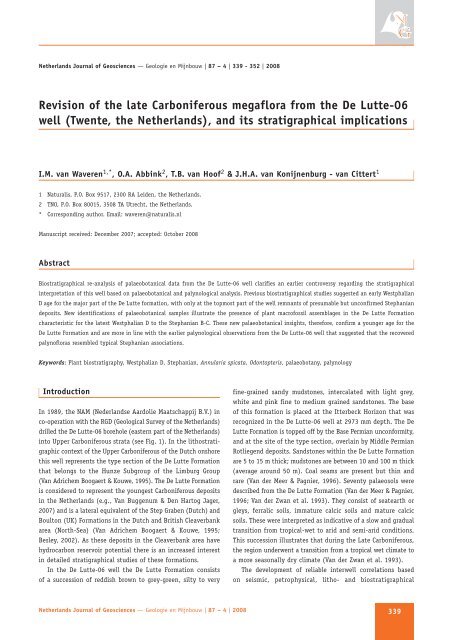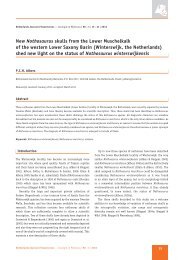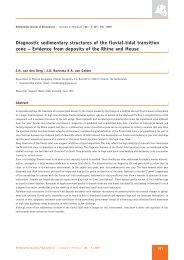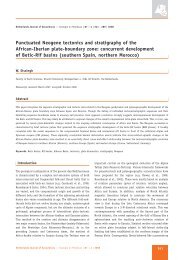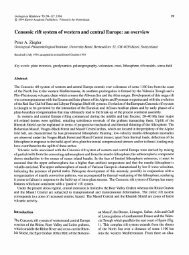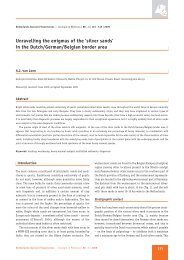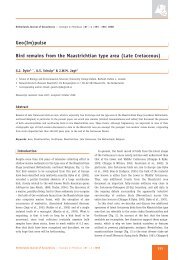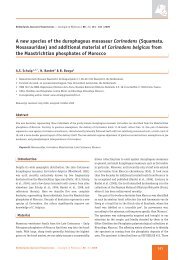Revision of the late Carboniferous megaflora from the De Lutte-06 ...
Revision of the late Carboniferous megaflora from the De Lutte-06 ...
Revision of the late Carboniferous megaflora from the De Lutte-06 ...
You also want an ePaper? Increase the reach of your titles
YUMPU automatically turns print PDFs into web optimized ePapers that Google loves.
Ne<strong>the</strong>rlands Journal <strong>of</strong> Geosciences — Geologie en Mijnbouw | 87 – 4 | 339 - 352 | 2008<br />
<strong>Revision</strong> <strong>of</strong> <strong>the</strong> <strong>late</strong> <strong>Carboniferous</strong> <strong>megaflora</strong> <strong>from</strong> <strong>the</strong> <strong>De</strong> <strong>Lutte</strong>-<strong>06</strong><br />
well (Twente, <strong>the</strong> Ne<strong>the</strong>rlands), and its stratigraphical implications<br />
I.M. van Waveren 1,* , O.A. Abbink 2 , T.B. van Ho<strong>of</strong> 2 & J.H.A. van Konijnenburg - van Cittert 1<br />
1 Naturalis, P.O. Box 9517, 2300 RA Leiden, <strong>the</strong> Ne<strong>the</strong>rlands.<br />
2 TNO, P.O. Box 80015, 3508 TA Utrecht, <strong>the</strong> Ne<strong>the</strong>rlands.<br />
* Corresponding author. Email: waveren@naturalis.nl<br />
Manuscript received: <strong>De</strong>cember 2007; accepted: October 2008<br />
Abstract<br />
Biostratigraphical re-analysis <strong>of</strong> palaeobotanical data <strong>from</strong> <strong>the</strong> <strong>De</strong> <strong>Lutte</strong>-<strong>06</strong> well clarifies an earlier controversy regarding <strong>the</strong> stratigraphical<br />
interpretation <strong>of</strong> this well based on palaeobotanical and palynological analysis. Previous biostratigraphical studies suggested an early Westphalian<br />
D age for <strong>the</strong> major part <strong>of</strong> <strong>the</strong> <strong>De</strong> <strong>Lutte</strong> formation, with only at <strong>the</strong> topmost part <strong>of</strong> <strong>the</strong> well remnants <strong>of</strong> presumable but unconfirmed Stephanian<br />
deposits. New identifications <strong>of</strong> palaeobotanical samples illustrate <strong>the</strong> presence <strong>of</strong> plant macr<strong>of</strong>ossil assemblages in <strong>the</strong> <strong>De</strong> <strong>Lutte</strong> Formation<br />
characteristic for <strong>the</strong> <strong>late</strong>st Westphalian D to <strong>the</strong> Stephanian B-C. These new palaeobotanical insights, <strong>the</strong>refore, confirm a younger age for <strong>the</strong><br />
<strong>De</strong> <strong>Lutte</strong> Formation and are more in line with <strong>the</strong> earlier palynological observations <strong>from</strong> <strong>the</strong> <strong>De</strong> <strong>Lutte</strong>-<strong>06</strong> well that suggested that <strong>the</strong> recovered<br />
palyn<strong>of</strong>loras resembled typical Stephanian associations.<br />
Keywords: Plant biostratigraphy, Westphalian D, Stephanian, Annularia spicata, Odontopteris, palaeobotany, palynology<br />
Introduction<br />
In 1989, <strong>the</strong> NAM (Nederlandse Aardolie Maatschappij B.V.) in<br />
co-operation with <strong>the</strong> RGD (Geological Survey <strong>of</strong> <strong>the</strong> Ne<strong>the</strong>rlands)<br />
drilled <strong>the</strong> <strong>De</strong> <strong>Lutte</strong>-<strong>06</strong> borehole (eastern part <strong>of</strong> <strong>the</strong> Ne<strong>the</strong>rlands)<br />
into Upper <strong>Carboniferous</strong> strata (see Fig. 1). In <strong>the</strong> lithostratigraphic<br />
context <strong>of</strong> <strong>the</strong> Upper <strong>Carboniferous</strong> <strong>of</strong> <strong>the</strong> Dutch onshore<br />
this well represents <strong>the</strong> type section <strong>of</strong> <strong>the</strong> <strong>De</strong> <strong>Lutte</strong> Formation<br />
that belongs to <strong>the</strong> Hunze Subgroup <strong>of</strong> <strong>the</strong> Limburg Group<br />
(Van Adrichem Boogaert & Kouwe, 1995). The <strong>De</strong> <strong>Lutte</strong> Formation<br />
is considered to represent <strong>the</strong> youngest <strong>Carboniferous</strong> deposits<br />
in <strong>the</strong> Ne<strong>the</strong>rlands (e.g., Van Buggenum & <strong>De</strong>n Hartog Jager,<br />
2007) and is a <strong>late</strong>ral equivalent <strong>of</strong> <strong>the</strong> Step Graben (Dutch) and<br />
Boulton (UK) Formations in <strong>the</strong> Dutch and British Cleaverbank<br />
area (North-Sea) (Van Adrichem Boogaert & Kouwe, 1995;<br />
Besley, 2002). As <strong>the</strong>se deposits in <strong>the</strong> Cleaverbank area have<br />
hydrocarbon reservoir potential <strong>the</strong>re is an increased interest<br />
in detailed stratigraphical studies <strong>of</strong> <strong>the</strong>se formations.<br />
In <strong>the</strong> <strong>De</strong> <strong>Lutte</strong>-<strong>06</strong> well <strong>the</strong> <strong>De</strong> <strong>Lutte</strong> Formation consists<br />
<strong>of</strong> a succession <strong>of</strong> reddish brown to grey-green, silty to very<br />
Ne<strong>the</strong>rlands Journal <strong>of</strong> Geosciences — Geologie en Mijnbouw | 87 – 4 | 2008<br />
fine-grained sandy mudstones, interca<strong>late</strong>d with light grey,<br />
white and pink fine to medium grained sandstones. The base<br />
<strong>of</strong> this formation is placed at <strong>the</strong> Itterbeck Horizon that was<br />
recognized in <strong>the</strong> <strong>De</strong> <strong>Lutte</strong>-<strong>06</strong> well at 2973 mm depth. The <strong>De</strong><br />
<strong>Lutte</strong> Formation is topped <strong>of</strong>f by <strong>the</strong> Base Permian unconformity,<br />
and at <strong>the</strong> site <strong>of</strong> <strong>the</strong> type section, overlain by Middle Permian<br />
Rotliegend deposits. Sandstones within <strong>the</strong> <strong>De</strong> <strong>Lutte</strong> Formation<br />
are 5 to 15 m thick; mudstones are between 10 and 100 m thick<br />
(average around 50 m). Coal seams are present but thin and<br />
rare (Van der Meer & Pagnier, 1996). Seventy palaeosols were<br />
described <strong>from</strong> <strong>the</strong> <strong>De</strong> <strong>Lutte</strong> Formation (Van der Meer & Pagnier,<br />
1996; Van der Zwan et al. 1993). They consist <strong>of</strong> seatearth or<br />
gleys, ferralic soils, immature calcic soils and mature calcic<br />
soils. These were interpreted as indicative <strong>of</strong> a slow and gradual<br />
transition <strong>from</strong> tropical-wet to arid and semi-arid conditions.<br />
This succession illustrates that during <strong>the</strong> Late <strong>Carboniferous</strong>,<br />
<strong>the</strong> region underwent a transition <strong>from</strong> a tropical wet climate to<br />
a more seasonally dry climate (Van der Zwan et al. 1993).<br />
The development <strong>of</strong> reliable interwell correlations based<br />
on seismic, petrophysical, litho- and biostratigraphical<br />
339
Fig. 1. Location map <strong>of</strong> <strong>the</strong> <strong>De</strong> <strong>Lutte</strong> 6 well, coloured sections indicate <strong>the</strong> presence <strong>of</strong> Westphalian D and Stephanian strata in <strong>the</strong> subsurface (courtesy<br />
<strong>of</strong> <strong>the</strong> SPBA project).<br />
interpretations for fluvial and alluvial red bed sequences such<br />
as <strong>the</strong> <strong>De</strong> <strong>Lutte</strong>, Step Graben and Boulton formations is difficult.<br />
Especially as <strong>the</strong>se red bed sequences in general do not yield<br />
very productive biostratigraphical data. Exceptionally, an<br />
assemblage <strong>of</strong> plantmacr<strong>of</strong>ossils toge<strong>the</strong>r with several intervals<br />
containing ra<strong>the</strong>r well preserved palyn<strong>of</strong>loras were recovered<br />
<strong>from</strong> <strong>the</strong> transition <strong>of</strong> <strong>the</strong> dark shales to <strong>the</strong> red beds in <strong>the</strong><br />
<strong>De</strong> <strong>Lutte</strong>-<strong>06</strong> well (Van Amerom, 1996a; Van de Laar & Van der<br />
Zwan, 1996). Therefore, <strong>the</strong> analysis <strong>of</strong> <strong>the</strong>se macro- and micr<strong>of</strong>ossils<br />
<strong>of</strong> <strong>the</strong> transition to <strong>the</strong> red bed is most relevant to<br />
improve <strong>the</strong> biostratigraphical framework within <strong>the</strong> Upper<br />
<strong>Carboniferous</strong> <strong>of</strong> <strong>the</strong> Ne<strong>the</strong>rlands.<br />
In <strong>the</strong> original publications on <strong>the</strong> biostratigraphy <strong>of</strong> <strong>the</strong> <strong>De</strong><br />
<strong>Lutte</strong>-<strong>06</strong> well, a discrepancy was noticed between <strong>the</strong> palaeobotanical<br />
and <strong>the</strong> palynological age assessment (Van Amerom,<br />
1996a; Van de Laar & Van der Zwan, 1996). The dating <strong>of</strong> <strong>the</strong><br />
<strong>De</strong> <strong>Lutte</strong>-<strong>06</strong> well was based on palaeobotanical comparisons<br />
with <strong>the</strong> zonal scheme <strong>of</strong> <strong>the</strong> Saar-Lorraine Basin defined by<br />
Cleal (1984). <strong>De</strong>spite <strong>the</strong> possibility <strong>of</strong> significant timetransgressive<br />
first occurrences <strong>of</strong> floral elements, comparisons<br />
were also made with records reported <strong>from</strong> Spain by Wagner and<br />
Alvarez-Vasquez, (1991) and Wales (Wagner & Spinner, 1974).<br />
The six macr<strong>of</strong>loral zones on which <strong>the</strong> <strong>De</strong> <strong>Lutte</strong>-<strong>06</strong> well<br />
were dated are as follows (Van Amerom, 1996a):<br />
– Interval 1 (32<strong>06</strong> m - ca 3115 m) – with Neuropteris obliqua,<br />
not younger than Westphalian C;<br />
340<br />
– Interval 2 (ca 3155 m - ca 2815 m) – <strong>the</strong> Linopteris<br />
bunburyi zone (including <strong>the</strong> base <strong>of</strong> <strong>the</strong> <strong>De</strong> <strong>Lutte</strong><br />
Formation), Westphalian C;<br />
– Interval 3 (ca 2815 m - ca 2695 m) – <strong>the</strong> Lobatopteris<br />
(Pecopteris) micromiltonii Zone, Westphalian D;<br />
– Interval 4 (2695 m - ca 2575 m) – <strong>the</strong> Reticulopteris<br />
muensteri zone, middle Westphalian D;<br />
– Sub-interval 5 (ca 2600 m - ca 2575 m) – with Walchia<br />
(Hermitia) sp., middle Westphalian D;<br />
– Interval 6 (2575 m - 2350 m) – with Pecopteris vestita,<br />
<strong>late</strong> Westphalian.<br />
In general, <strong>the</strong> palynological data suggested a younger age<br />
for <strong>the</strong> <strong>De</strong> <strong>Lutte</strong> Formation (Van de Laar & Van der Zwan 1996).<br />
Three successive assemblages were recognized (see also Van<br />
der Zwan et al., 1993).<br />
The lower Assemblage I (recorded <strong>from</strong> <strong>the</strong> Tubbergen<br />
Formation interval 3081.44 - 3193.67 m (27 samples) is characterized<br />
by a dominance <strong>of</strong> monosaccate pollen. Taeniate and<br />
non-taeniate bisaccate pollen are present toge<strong>the</strong>r with<br />
Savistrisporites nux, cf. Lundbladispora gigantea, Cirratriradites<br />
saturnii, Vestispora spp., Florinites spp. and Potonieisporites<br />
spp.<br />
Assemblage II (<strong>from</strong> <strong>the</strong> Itterbeck Horizon, interval<br />
2972.45 - 2973.65 m (5 samples) is dominated by trilete spores<br />
like Calamospora spp. and Lycospora spp.; Laevigatosporites<br />
Ne<strong>the</strong>rlands Journal <strong>of</strong> Geosciences — Geologie en Mijnbouw | 87 – 4 | 2008
spp. and Triquitrites spp. are common. Saccate pollen grains<br />
are rare, whereas taeniate bisaccate pollen grains are absent.<br />
The upper Assemblage III (interval 281.85 - 2780.75 m,<br />
(14 samples) is dominated by Potonieisporites spp. and/or<br />
Endosporites globiformis. Florinites spp., taeniate and nontaeniate<br />
bisaccate and monosaccate pollen are common.<br />
Cordaitina spp., Illinites unicus and Striatodiplopinites spp.,<br />
although irregularly found in Assemblage I, represent a very<br />
characteristic feature in Assemblage III.<br />
Van de Laar and Van der Zwan (1996) compared <strong>the</strong> palynological<br />
record <strong>of</strong> <strong>the</strong> <strong>De</strong> <strong>Lutte</strong> well with successions <strong>from</strong> <strong>the</strong><br />
UK, Poland, Ukraine and <strong>the</strong> USA. They stated that <strong>the</strong><br />
dominance <strong>of</strong> monolete spores as observed in <strong>late</strong> Westphalian<br />
C to early Stephanian OT (Thymospora obscura - Thymospora<br />
thiessenii) Zone <strong>of</strong> Clayton et al. (1977) is absent in <strong>the</strong>ir data<br />
set. As was already mentioned earlier (Van der Zwan et al.<br />
1993), <strong>the</strong> <strong>De</strong> <strong>Lutte</strong> assemblages show more affinity to <strong>the</strong><br />
NBM (Potonieisporites novicus-bharadwajii-Cheledonites major)<br />
Zone <strong>of</strong> <strong>late</strong>st Stephanian B to Stephanian ‘D’ age and <strong>the</strong> early<br />
Autunian VC (Vittatina costabilis) Zone <strong>of</strong> Clayton et al. (1977).<br />
However, based on <strong>the</strong> very low amount <strong>of</strong> age diagnostic<br />
palynomorphs and in spite <strong>of</strong> <strong>the</strong> distinct Stephanian aspects<br />
<strong>of</strong> <strong>the</strong> pollen record <strong>of</strong> <strong>the</strong> <strong>De</strong> <strong>Lutte</strong> 6 well, it was decided to<br />
adopt <strong>the</strong> palaeobotanical age interpretations for <strong>the</strong> palynological<br />
record (Van de Laar & Van der Zwan 1996; Van der Zwan<br />
et al., 1993; Van Amerom, 1996a). A <strong>late</strong> Westphalian C age<br />
was assigned to Assemblage I and an early Westphalian D age<br />
to Assemblages II and III.<br />
The presence <strong>of</strong> Stephanian-type or Autunian-type palyn<strong>of</strong>loras<br />
during <strong>the</strong> early Westphalian D was interpreted as<br />
re<strong>late</strong>d to <strong>the</strong> early occurrence <strong>of</strong> local xeric plant communities<br />
during <strong>the</strong> early Westphalian D (Van Amerom, 1996a; Van de<br />
Laar & Van der Zwan, 1996). However recent palynostratigraphical<br />
studies <strong>of</strong> <strong>the</strong> <strong>late</strong> <strong>Carboniferous</strong> <strong>of</strong> Western Europe<br />
do not support <strong>the</strong> view that precursor Stephanian-type<br />
palyn<strong>of</strong>loras may already occur in Westphalian D deposits<br />
(McLean et al., 2005; Hartkopf-Fröder, 2005).<br />
A reassessment <strong>of</strong> <strong>the</strong> biostratigraphical significance <strong>of</strong> <strong>the</strong><br />
<strong>De</strong> <strong>Lutte</strong>-<strong>06</strong> macr<strong>of</strong>lora is <strong>the</strong>refore necessary. Comparison with<br />
macr<strong>of</strong>loras <strong>from</strong> remote areas is avoided as e.g. Neuropteris<br />
ovata and N. scheuchzeri, relevant in <strong>the</strong> present study, are<br />
considered relicts in North America (Lyons & Zodrow, 1995).<br />
Moreover Sphenophyllum verticillatum, also relevant in <strong>the</strong><br />
present study, has a range in <strong>the</strong> far east (China) running<br />
<strong>from</strong> <strong>the</strong> Yanghukou Formation (situated at <strong>the</strong> transition<br />
<strong>from</strong> <strong>the</strong> Namurian and <strong>the</strong> Westphalian) to <strong>the</strong> Stephanian<br />
(Li et al., 1991) while it has a much more restricted range in<br />
central Europe (Remy & Remy, 1977). Clearly east-west<br />
correlations are very complex, and can at best be carried out<br />
at a generic level for palaeobiogeographical and nomenclatorial<br />
reasons (Hilton and Cleal, 2007). Within Variscan Euramerica,<br />
both east-west and north-south correlations are also strongly<br />
influenced by biogeographical factors. This can best be inferred<br />
Ne<strong>the</strong>rlands Journal <strong>of</strong> Geosciences — Geologie en Mijnbouw | 87 – 4 | 2008<br />
<strong>from</strong> lyginopterid and medullosean assemblages indicating<br />
<strong>the</strong> existence <strong>of</strong> a Rhine palaeoprovince, distinct <strong>from</strong> o<strong>the</strong>r<br />
palaeoprovinces, <strong>the</strong> Iberian and Silesian in particular (Cleal,<br />
2008a, 2008b). Indeed Variscan Euramerica is <strong>the</strong> object <strong>of</strong><br />
divergent palaeogeographical reconstructions (Scotese, 2005,<br />
Shi, 20<strong>06</strong>, Stampfli & Borel, 2004). Moreover <strong>the</strong> rapid shrinking<br />
<strong>of</strong> <strong>the</strong> coal forming wetlands at <strong>the</strong> Permo-<strong>Carboniferous</strong><br />
transition indicates that Variscan Euramerica was a<br />
palaeoecologically sensitive area. The macro- and micr<strong>of</strong>ossil<br />
record has to be a function <strong>of</strong> <strong>the</strong> p<strong>late</strong> movement, <strong>the</strong> local<br />
palaeogeography on ei<strong>the</strong>r side <strong>of</strong> <strong>the</strong> Variscan mountains, or<br />
<strong>of</strong> <strong>the</strong> changing width <strong>of</strong> <strong>the</strong> palaeoecological zones. For <strong>the</strong><br />
purpose <strong>of</strong> age assessment it is <strong>the</strong>refore crucial to corre<strong>late</strong><br />
within <strong>the</strong> palaeoprovince <strong>of</strong> <strong>the</strong> <strong>De</strong> <strong>Lutte</strong>-<strong>06</strong> well, e.g. <strong>the</strong><br />
Rhine palaeoprovince (Cleal, 2008b , fig 1). Several important<br />
wells (including <strong>the</strong> Itterbeck-Halle 5, Norddeutschland 8 and<br />
Freswegen 5) located very close to <strong>the</strong> Dutch-German border<br />
(Josten, 1995) belong in <strong>the</strong> Rhine palaeoprovince.<br />
Considerable knowledge on <strong>the</strong> middle and <strong>late</strong> <strong>Carboniferous</strong><br />
macr<strong>of</strong>loras (Namurian to Westphalian D) was already made<br />
available in a standard work (Josten, 1991) based on various<br />
earlier studies (Josten 1966; 1970; Josten & Teichmüller,<br />
1971; Josten & Laveine 1984) but more specifically a study <strong>of</strong><br />
<strong>the</strong> <strong>late</strong> <strong>Carboniferous</strong>-Permian transition (Westphalian D,<br />
Stephanian and Rotliegend) was also published <strong>late</strong>ly (Josten<br />
& Van Amerom, 1999). A comprehensive compilation <strong>of</strong> all <strong>of</strong><br />
<strong>the</strong>se <strong>late</strong> <strong>Carboniferous</strong> macr<strong>of</strong>ossil records <strong>from</strong> NW Germany<br />
has now become available (Josten, 2005).<br />
Comparison with this extensive data set specific to <strong>the</strong> Rhine<br />
palaeoprovince, in association with a critical reappraisal <strong>of</strong> <strong>the</strong><br />
available macr<strong>of</strong>lora remains <strong>from</strong> <strong>the</strong> <strong>De</strong> <strong>Lutte</strong>-<strong>06</strong> well will<br />
provide <strong>the</strong> appropriate basis for <strong>the</strong> age-assessment <strong>of</strong> <strong>the</strong> <strong>De</strong><br />
<strong>Lutte</strong>-<strong>06</strong> macr<strong>of</strong>lora. Therefore, in order to resolve <strong>the</strong> apparent<br />
controversy between palaeobotanical and palynological results,<br />
this paper is focusing on an update and stratigraphical reanalysis<br />
<strong>of</strong> <strong>the</strong> palaeobotanical data <strong>from</strong> <strong>the</strong> <strong>De</strong> <strong>Lutte</strong>-<strong>06</strong> well.<br />
Material and Methods<br />
The present study uses <strong>the</strong> biostratigraphic occurrences <strong>of</strong><br />
plant macr<strong>of</strong>ossils as described <strong>from</strong> wells drilled in <strong>the</strong> vicinity<br />
<strong>of</strong> <strong>the</strong> <strong>De</strong> <strong>Lutte</strong> in northwestern Germany (Josten 2005).<br />
Toge<strong>the</strong>r with additional sampling <strong>of</strong> <strong>the</strong> wells and an update<br />
<strong>of</strong> <strong>the</strong> taxonomy, <strong>the</strong>se stratigraphical ranges <strong>of</strong> <strong>the</strong> taxa <strong>from</strong><br />
a nearby basin will provide a more up to date view on <strong>the</strong><br />
problems re<strong>late</strong>d to <strong>the</strong> biostratigraphical framework <strong>of</strong> <strong>the</strong> <strong>De</strong><br />
<strong>Lutte</strong>-<strong>06</strong> well. Since this study deals with data <strong>from</strong> Western<br />
Europe, age interpretations are expressed in accordance to <strong>the</strong><br />
regional chronostratigraphical scheme as recently modified<br />
by <strong>the</strong> IUGS Subcommission on <strong>Carboniferous</strong> Stratigraphy<br />
(Heckel & Clayton, 20<strong>06</strong>). Approximate equivalency <strong>of</strong> regional<br />
terrestrial substages to global stage subdivision is indicated in<br />
Figure 2.<br />
341
The specimens used in this report are housed in <strong>the</strong><br />
National Museum <strong>of</strong> Natural History in Leiden, Naturalis. All<br />
available specimens <strong>of</strong> Van Amerom (1996a) were re-examined.<br />
The <strong>De</strong> <strong>Lutte</strong>-<strong>06</strong> core (TNO) was re-sampled for additional plant<br />
macr<strong>of</strong>ossils. During our new sampling <strong>of</strong> <strong>the</strong> <strong>De</strong> <strong>Lutte</strong>-<strong>06</strong> core<br />
no new species were observed. Only one new specimen,<br />
Annularia sphenophylloides, was added to <strong>the</strong> flora list.<br />
All specimens were assigned an exact core depth; <strong>the</strong>se are<br />
used to indicate which specimens are exactly meant in <strong>the</strong><br />
description, because previously used sample numbers appeared<br />
to be confusing. For sake <strong>of</strong> security, <strong>the</strong> depth in <strong>the</strong> core is<br />
used here as <strong>the</strong> sample number.<br />
The uncertainty <strong>of</strong> age assignment based on <strong>the</strong> palaeontological<br />
content is expressed according to <strong>the</strong> conventions<br />
established for <strong>the</strong> International Stratigraphic Guide (Murphy<br />
& Salvador, 1999).<br />
Results<br />
Identifications <strong>of</strong> <strong>the</strong> <strong>De</strong> <strong>Lutte</strong>-<strong>06</strong> macr<strong>of</strong>loral elements<br />
Hepaticites tortuosus Van Amerom<br />
<strong>De</strong>scription<br />
Thin ribbon-like fragments <strong>of</strong> about 0.5 cm wide and 3 cm long<br />
with a mid vein are observed (see also van Amerom, 1996b).<br />
Chronostratigraphical range<br />
Not relevant.<br />
Occurrence depth<br />
2781.29 m<br />
Calamites sp.<br />
<strong>De</strong>scription<br />
Fragments where <strong>the</strong> intermodal distance is larger than <strong>the</strong><br />
diameter <strong>of</strong> <strong>the</strong> stem. Furrows thin, 10 - 14 per centimetre.<br />
342<br />
Chronostratigraphical range<br />
<strong>De</strong>vonian to end Permian.<br />
Occurence depth<br />
3029,65 - 2308.69 m.<br />
Annularia sphenophylloides (Zenker) Gutbier (Fig. 3)<br />
<strong>De</strong>scription<br />
Internode length approximately 10 mm. Thickness <strong>of</strong> <strong>the</strong> axis<br />
unknown. Whorls have 14 to 16 leaves, 4 to 5 mm long and<br />
1.5 mm wide. Leaves symmetrically spatu<strong>late</strong> to ellipsoidal, no<br />
midvein visible, occasionally mucronate.<br />
Remarks<br />
The leaves observed here sometimes are ellipsoidal and<br />
consequently resemble <strong>the</strong> variability observed by Lesquereux<br />
(1880) in North American deposits.<br />
Chronostratigraphical range in North West Germany<br />
Westphalian A to Autunian (Josten, 2005).<br />
Occurrence depth<br />
2518.62 - 2569.70 m.<br />
Annularia spicata Gutbier (Fig. 4)<br />
Fig. 2. Global and regional chronostratigraphical<br />
subdivision charts <strong>of</strong> <strong>the</strong><br />
Pennsylvanian (Upper <strong>Carboniferous</strong>)<br />
Permian transition (after Menning et<br />
al., 2005).<br />
<strong>De</strong>scription<br />
Very small whorls with 6 to 8 leaves. Leaves with ra<strong>the</strong>r obtuse<br />
apices and parallel sides, length 2 to 3 mm and width 1 mm or<br />
less, widest point if detectible, in <strong>the</strong> distal half <strong>of</strong> <strong>the</strong> leaf,<br />
no midvein.<br />
Remarks<br />
Annularia spicata and A. galioides have <strong>of</strong>ten been confused<br />
because <strong>the</strong>y are <strong>of</strong> <strong>the</strong> same size and have a similar number<br />
<strong>of</strong> leaves per whorl (Jongmans, 1911; Crookall, 1969). The leaf<br />
shape <strong>of</strong> in our specimen differs <strong>from</strong> that <strong>of</strong> A. galioides in<br />
Ne<strong>the</strong>rlands Journal <strong>of</strong> Geosciences — Geologie en Mijnbouw | 87 – 4 | 2008
Fig. 3. Annularia sphenophylloides (scale bar = 1 cm).<br />
Fig. 4. Annularia spicata (scale bar = 1 cm).<br />
having <strong>the</strong> widest point in <strong>the</strong> apical part. This is a diagnostic<br />
feature <strong>of</strong> A. spicata. For this reason we refer <strong>the</strong> material<br />
identified earlier as A. galioides to A. spicata.<br />
Chronostratigraphical range in North West Germany<br />
Stephanian B to C (Josten, 2005).<br />
Occurrence depth<br />
2547.0 m.<br />
Sphenophyllum verticillatum (Schlo<strong>the</strong>im) Brongniart<br />
(Fig. 5)<br />
<strong>De</strong>scription<br />
The available material consists <strong>of</strong> a single whorl <strong>of</strong> 6 approximately<br />
equal-sized symmetrical leaves 5 to 7 mm long and<br />
3 mm wide. Veins bifurcate, tips rounded, rare teeth on margin.<br />
Ne<strong>the</strong>rlands Journal <strong>of</strong> Geosciences — Geologie en Mijnbouw | 87 – 4 | 2008<br />
Fig. 5. Sphenophyllum verticillatum (scale bar = 1 cm).<br />
Remark<br />
According to Batenburg (1977) Sphenophyllum verticillatum<br />
(Schlo<strong>the</strong>im) was invalidly published, he suggested <strong>the</strong> name<br />
Sphenophyllum marsiliaefolium. Although he was correct, his<br />
proposal did not find broad acceptance.<br />
Chronostratigraphical range in North West Germany<br />
Stephanian A to B (Josten, 2005).<br />
Occurrence depth<br />
2587.53 m.<br />
Sphenophyllum emarginatum (Brongniart) Brongniart<br />
(see Van Amerom, 1996 a, p<strong>late</strong> 1, fig. 2)<br />
<strong>De</strong>scription<br />
A sphenophyll with leaves with short apical teeth. The preservation<br />
is not very good.<br />
Remarks<br />
Van Amerom (1996a) identified this as S. cuneifolium, without<br />
a description. The specimen that was illustrated in Van Amerom<br />
(1996a) is identified here as S. emarginatum because where<br />
<strong>the</strong> teeth are visible, <strong>the</strong>y are too short, too rounded and too<br />
frequent to identify this taxon as S. cuneifolium. Spenophyllum<br />
cuneifolium has fewer, longer and more pointed narrower<br />
teeth.<br />
Chronostratigraphical range in North West Germany<br />
Upper Westphalian B to Stephanian C (Josten, 2005).<br />
Occurrence depth<br />
2518 m.<br />
343
Lobatopteris micromiltonii (P. Bertrand) Corsin (Fig.6)<br />
<strong>De</strong>scription<br />
Pinnae 7 - 10 mm long and 2.5 to 3 mm wide. Minute pinnules<br />
1 - 1.5 mm long and 0.5 to 1 mm wide. Pinnules clearly individualized<br />
with a sunken midvein. Secondary veins bifurcate<br />
at least once and at a small angle. Veins arise <strong>from</strong> <strong>the</strong> midvein<br />
and bend towards <strong>the</strong> apical margin.<br />
Chronostratigraphical range in North West Germany<br />
Upper Westphalian D (Josten, 2005).<br />
Occurrence depth<br />
2781.15 - 2887.9 m.<br />
Fig. 6. Lobatopteris micromiltonii (scale bar = 1 cm).<br />
Lobatopteris lamuriana (Heer) Wagner (Figs 7a and 7b)<br />
<strong>De</strong>scription<br />
Rounded obtuse lobate pinnules, length 4.5 to 5.5 mm, width<br />
<strong>of</strong> 3 mm, arising <strong>from</strong> <strong>the</strong> rachis at approximately 30°. Lateral<br />
veins branching at an angle <strong>of</strong> approximately 45° and slightly<br />
decurrent at <strong>the</strong> midvein. Veins straight, bifurcating first near<br />
midvein and again more than half way to <strong>the</strong> laminar margin.<br />
Remark<br />
The terminal pinnule is more acute than in P. vestita.<br />
Chronostratigraphical range in North West Germany<br />
Middle Westphalian D to Stephanian C (Josten, 2005).<br />
Occurrence depth<br />
2699 and 2781 m.<br />
344<br />
Fig. 7a. Lobatopteris lamuriana (scale bar = 1 cm).<br />
Fig. 7b. <strong>De</strong>tail <strong>of</strong> pinnule venation <strong>of</strong> Lobatopteris lamuriana.<br />
Ne<strong>the</strong>rlands Journal <strong>of</strong> Geosciences — Geologie en Mijnbouw | 87 – 4 | 2008
Odontopteris schlo<strong>the</strong>imii Brongniart (Figs 8 and 9)<br />
<strong>De</strong>scription<br />
A single apical fragment with radiating veins was recovered.<br />
The fragment is about 2.5 cm long. The pinnules are oval. The<br />
apex is rounded. The pinnules are 10 mm long and 5 mm wide<br />
with loosely spaced veins. Veins are faint but when visible, <strong>the</strong><br />
pinnules is fed by several veins leaving <strong>the</strong> rachis (see Fig. 9).<br />
These features are found in odontopterids.<br />
Remarks<br />
It is hard to differentiate between different odontopterid based<br />
small fragments, but <strong>the</strong> pinnule shape is more similar to O.<br />
schlo<strong>the</strong>imii than to O. subcrenulata which has more rounded<br />
pinnules, higher vein density and overlapping pinnules. The<br />
specimens observed in Spain (Wagner et al., 1969), have smaller<br />
more slender pinnules than Odontopteris schlo<strong>the</strong>imii, and are<br />
believed to represent a different species which was called<br />
Odontopteris cantabrica Wagner. The occurrence in <strong>the</strong> lower<br />
Cantabrian, was considered as a diagnostic feature. The validity<br />
<strong>of</strong> <strong>the</strong> species is not questioned, but only its justification as<br />
fur<strong>the</strong>r study <strong>of</strong> <strong>the</strong> cuticule <strong>of</strong> Odontopteris schlo<strong>the</strong>imii<br />
could still prove to support <strong>the</strong> establishment <strong>of</strong> Odontopteris<br />
cantabrica Wagner (Cleal et al., 2007).<br />
Odontopteris cantabrica is mentioned in a listing <strong>of</strong> <strong>the</strong><br />
species found in <strong>the</strong> Heusweiler formation (Stephanian B) <strong>of</strong><br />
<strong>the</strong> Saar-Nahe basin (Kerp et al., 2007). Considering <strong>the</strong><br />
diagnosis (Wagner et al., 1969), this would not be possible; on<br />
<strong>the</strong> o<strong>the</strong>r hand, if Odontopteris schlo<strong>the</strong>imii and Odontopteris<br />
cantabrica are <strong>the</strong> same species than this extends <strong>the</strong> range <strong>of</strong><br />
Odontopteris schlo<strong>the</strong>imii into <strong>the</strong> Cantabrian or <strong>the</strong> range <strong>of</strong><br />
Odontopteris cantabrica up to <strong>the</strong> Stephanian B.<br />
Chronostratigraphical range in North West Germany<br />
Stephanian ( Josten, 2005; Josten & Van Amerom, 1999).<br />
N.B. Odontopteris schlo<strong>the</strong>imii was validly described by<br />
Brongniart (1828) and is typical <strong>of</strong> East Germany where it was<br />
found by Schlo<strong>the</strong>im in Rotliegend deposits <strong>from</strong> Thuringia<br />
(Brongniart, 1828). Thuringian upper Palaeozoic deposits belong<br />
to <strong>the</strong> central Bohemian palaeoprovince (Cleal, 2008b), consequently<br />
this range is not considered relevant in <strong>the</strong> present<br />
study. The French Stephanian basins <strong>from</strong> central France also hold<br />
Odontopteris schlo<strong>the</strong>imii (Doubinger et al., 1995; Zeiller, 1880).<br />
These small pull-apart limnic basins might represent atypical<br />
local microclimates and utmost caution is requested for detailed<br />
age evaluation <strong>of</strong> <strong>the</strong>se complex basins. Based on <strong>the</strong> palaeoprovincial<br />
affinities <strong>of</strong> <strong>the</strong> euramerican coal basins (Cleal, 2008b),<br />
<strong>the</strong> French central basins are here expected to have Iberian/<br />
Silesian affinities. These basins cannot be used for calibrating<br />
<strong>the</strong> macr<strong>of</strong>loral associations <strong>from</strong> <strong>the</strong> Rhine palaeoprovince.<br />
Occurrence depth<br />
2781.45 m.<br />
Ne<strong>the</strong>rlands Journal <strong>of</strong> Geosciences — Geologie en Mijnbouw | 87 – 4 | 2008<br />
Fig. 8. Odontopteris schlo<strong>the</strong>imii (scale bar = 1 cm).<br />
Fig. 9. Venation <strong>of</strong> Odontopteris schlo<strong>the</strong>imii.<br />
345
Neuropteris ovata H<strong>of</strong>fman (Fig. 10)<br />
<strong>De</strong>scription<br />
Pinnule with clear midvein reaching until one third <strong>of</strong> <strong>the</strong><br />
pinnule, dense venation. This is diagnostic for Neuropteris<br />
ovata (Josten, 1991).<br />
Chronostratigraphical range North West Germany<br />
Westphalian D (Josten, 2005).<br />
Occurrence depth<br />
2781.54 m.<br />
Fig. 10. Neuropteris ovata (scale bar = 1 cm).<br />
Neuropteris scheuchzeri H<strong>of</strong>fmann (Figs 11 and 12)<br />
<strong>De</strong>scription<br />
Several elongated pinnules with strongly decurrent, very fine,<br />
bifurcating venation. Clear midvein. Single fragment clearly<br />
shows apical tapering part <strong>of</strong> pinnule.<br />
Remark<br />
Neuropteris scheuchzeri can easily be recognized by <strong>the</strong> ra<strong>the</strong>r<br />
large hairs on <strong>the</strong> upper pinnule surface. These are however<br />
not observed on <strong>the</strong> present specimen. In North America a<br />
similar form is found in <strong>the</strong> Appalachian coalfields, also without<br />
<strong>the</strong>se hairs (pers. comms H. Kerp, 2008).<br />
Chronostratigraphical range in North West Germany<br />
Westphalian B, C and lower Westphalian D (Josten, 2005).<br />
Occurrence depth<br />
3165 m.<br />
Neuropteris obliqua (Brongniart) Zeiller (Fig. 13)<br />
<strong>De</strong>scription<br />
Lax pinnule venation, midvein running till three quarters <strong>of</strong><br />
<strong>the</strong> length <strong>of</strong> <strong>the</strong> pinnule.<br />
346<br />
Fig. 11. Badly preserved Neuropteris scheuchzeri with elongated apical<br />
part <strong>of</strong> pinnule (scale bar = 1 cm).<br />
Chronostratigraphical range in North West Germany<br />
Namurian to Westphalian D (Josten, 2005).<br />
Occurrence depth<br />
3128.9 m.<br />
Cordaites principalis (Germar) Geinitz<br />
<strong>De</strong>scription<br />
Slender tips <strong>of</strong> leaves are observed in <strong>the</strong> cuttings. Vein<br />
alternations between thicker and thinner veins irregular, 3 - 5<br />
thinner veins observed between <strong>the</strong> thicker ones.<br />
Ne<strong>the</strong>rlands Journal <strong>of</strong> Geosciences — Geologie en Mijnbouw | 87 – 4 | 2008
Fig. 12. Atypical well preserved Neuropteris scheuchzeri pinnule (scale<br />
bar = 1 cm).<br />
Chronostratigraphical range in North West Germany<br />
Namurian to Stephanian (Josten, 2005).<br />
Occurrence depth<br />
2268.19 and 3042.68 m.<br />
Hermitia (Walchia) sp. (Fig. 14)<br />
<strong>De</strong>scription<br />
Clear but small falcate needles 10 mm long on a small twig<br />
were identified in <strong>the</strong> dark grey shales deeper in <strong>the</strong> core, also<br />
a whole branch <strong>of</strong> 10 cm length with alternating twigs in one<br />
plane on each side <strong>of</strong> <strong>the</strong> main rachis was observed in <strong>the</strong> red<br />
shales higher up in <strong>the</strong> core.<br />
Remark<br />
Hermitia is a morphogenus used for walchian remains that do<br />
not posses reproductive structures nor a cuticle.<br />
Ne<strong>the</strong>rlands Journal <strong>of</strong> Geosciences — Geologie en Mijnbouw | 87 – 4 | 2008<br />
Fig. 13. Neuropteris obliqua (scale bar = 1 cm).<br />
Chronostratigraphical range in North West Germany<br />
Upper Stephanian to Autunian (Josten, 2005).<br />
Occurrence depth<br />
2589.5 and 2781.57 m.<br />
Age interpretation (see Fig. 15)<br />
Interval 2518 - 2547 m – Stephanian B - C<br />
The top boundary <strong>of</strong> this interval is defined by what is<br />
considered <strong>the</strong> last occurrence date (LOD) <strong>of</strong> Sphenophyllum<br />
emarginatum at 2518.00 m. The lower boundary is defined by<br />
<strong>the</strong> occurrence <strong>of</strong> Annularia spicata at 2547.45 m depth (single<br />
occurrence in well). In NW Germany S. emarginatum has its<br />
LOD in <strong>the</strong> Stephanian C while A. spicata was found in <strong>the</strong><br />
Stephanian B and C (Josten, 2005). Therefore this interval is<br />
considered to be Stephanian B - C in age.<br />
347
Fig. 14. Hermitia (Walchia) sp. branch with typical symmetrical vegetative<br />
shoots sprouting on ei<strong>the</strong>r side <strong>of</strong> a main axis (scale bar = 1 cm).<br />
Interval 2587 - 2781 m – Stephanian A - B<br />
The top <strong>of</strong> this interval is defined by <strong>the</strong> LOD <strong>of</strong> Sphenophyllum<br />
verticillatum at 2587.53 m. The base <strong>of</strong> this interval is defined<br />
by <strong>the</strong> FOD <strong>of</strong> Lobatopteris lamuriana at 2781m depth. In NW<br />
Germany Sphenophyllum verticillatum has a range <strong>of</strong> Stephanian<br />
A - B (Josten, 2005). Pecopteris lamuriana has a range in NW<br />
Germany <strong>of</strong> middle Westphalian D to Stephanian C (Josten,<br />
2005). Within this interval at 2589.5 m Hermitia (Walchia) sp.<br />
was observed. In NW Germany this taxon first appears in <strong>the</strong><br />
macr<strong>of</strong>loral record <strong>of</strong> <strong>the</strong> <strong>late</strong> Stephanian (Josten, 2005). It<br />
should be noted, however, that earlier appearance dates for<br />
conifers have been reported in <strong>De</strong>smoinesian (approximately<br />
Westphalian D) <strong>of</strong> North America (Lyons & Darrah, 1989;<br />
Rothwell et al., 1997; Hernandez-Castillo et al., 2001) but<br />
also in Great Britain (Scott, 1974), and in NW Germany, in<br />
Ibbenbüren, in Westpahalian D deposits (Raabe and Remy,<br />
1964). Based on <strong>the</strong> age <strong>of</strong> <strong>the</strong> underlying interval, this<br />
interval is considered to be <strong>of</strong> Stephanian A -B age.<br />
348<br />
Interval 2781.24 - 2781.45 m – earliest Stephanian<br />
(Cantabrian)<br />
The top <strong>of</strong> this interval is defined by <strong>the</strong> LOD <strong>of</strong> Lobatopteris<br />
micromiltonii at 2781.15 m depth. The base <strong>of</strong> <strong>the</strong> interval is<br />
defined at <strong>the</strong> FOD <strong>of</strong> Odontopteris schlo<strong>the</strong>imii at 2781.45 m<br />
depth (single occurrence in well). This interval is characterized<br />
by <strong>the</strong> co-occurrence <strong>of</strong> Lobatopteris micromiltonii (at 2781.35<br />
m and 2781.24 m) and Odontopteris schlo<strong>the</strong>imii (2781.45 m).<br />
In NW Germany, Lobatopteris micromiltonii is restricted to <strong>the</strong><br />
<strong>late</strong> Westphalian D (Josten, 2005). Odontopteris schlo<strong>the</strong>imii<br />
has a narrow range in NW Germany and is typical <strong>of</strong> Stephanian<br />
deposits (Josten, 2005). The co-occurrence <strong>of</strong> <strong>the</strong>se taxa in<br />
this interval is typical and can be interpreted to represent an<br />
earliest Stephanian age, where a relict Westphalian D taxon<br />
(Lobatopteris micromiltonii) persists into <strong>the</strong> earliest Stephanian<br />
(Cantabrian). Therefore this interval is considered to be <strong>of</strong><br />
earliest Stephanian age.<br />
Remark: in <strong>the</strong> absence <strong>of</strong> a cuticle <strong>from</strong> Odontopteris<br />
schlo<strong>the</strong>imii it cannot be decided if this odontopterid is O.<br />
cantabrica typical <strong>of</strong> <strong>the</strong> early Cantabrian (Cleal et al., 2007).<br />
Interval 2781.54m - 2887.90 m – Westphalian D<br />
The top <strong>of</strong> this interval is placed at <strong>the</strong> LOD <strong>of</strong> Neuropteris ovata<br />
at 2781.54 m depth (single occurrence in well). The base <strong>of</strong><br />
this interval is placed at <strong>the</strong> FOD <strong>of</strong> Lobatopteris micromiltonii<br />
at 2887.9 m depth. Neuropteris ovata has a stratigraphical range<br />
<strong>of</strong> Westphalian D and Lobatopteris micromiltonii is restricted<br />
to <strong>the</strong> Westphalian D in NW Germany. Therefore this interval<br />
is considered to be <strong>of</strong> Westphalian D age.<br />
Interval 3128.9 - 3165 m – early Westphalian D or older<br />
The top <strong>of</strong> this interval is placed at <strong>the</strong> LOD <strong>of</strong> Neuropteris<br />
obliqua at 3128.9 m depth (single occurrence in well). The<br />
base <strong>of</strong> this interval is placed at <strong>the</strong> FOD <strong>of</strong> Neuropteris<br />
scheuchzeri at 3164.5 m. depth (single occurrence in well). In<br />
NW Germany Neuropteris obliqua has a range <strong>of</strong> Namurian to<br />
Westphalian D while Neuropteris scheuchzeri has its LOD in <strong>the</strong><br />
early Westphalian D. This interval is <strong>the</strong>refore considered to be<br />
<strong>of</strong> early Westphalian D or older age.<br />
Discussion<br />
The present biostratigraphical interpretation based on plant<br />
macr<strong>of</strong>ossils suggests a Westphalian D to Stephanian age for<br />
<strong>the</strong> <strong>De</strong> <strong>Lutte</strong> Formation. In <strong>the</strong> <strong>De</strong> <strong>Lutte</strong>-<strong>06</strong> well <strong>the</strong> revised<br />
biostratigraphical interpretation lowers <strong>the</strong> Westphalian/<br />
Stephanian boundary by about 430 meters compared to earlier<br />
interpretations (Van Amerom 1996a, Van der Meer & Pagnier,<br />
1996).<br />
Ne<strong>the</strong>rlands Journal <strong>of</strong> Geosciences — Geologie en Mijnbouw | 87 – 4 | 2008
Fig. 15. Revised chronostratigraphical interpretation <strong>of</strong> <strong>the</strong> <strong>De</strong> <strong>Lutte</strong>-<strong>06</strong> macr<strong>of</strong>loral record. Occurrences <strong>of</strong> <strong>the</strong> taxa are in red, in blue are <strong>the</strong> occurrences<br />
on which <strong>the</strong> age determination was based.<br />
This revision <strong>of</strong> <strong>the</strong> palaeobotanical age-interpretation is<br />
more in agreement with <strong>the</strong> previous palynological interpretations<br />
(Van de Laar & Van der Zwan, 1996; see also Fig. 15) that<br />
suggested <strong>the</strong> presence <strong>of</strong> a Stephanian-Autunian palyn<strong>of</strong>lora<br />
Ne<strong>the</strong>rlands Journal <strong>of</strong> Geosciences — Geologie en Mijnbouw | 87 – 4 | 2008<br />
in <strong>the</strong> <strong>De</strong> <strong>Lutte</strong> Formation (Assemblage III). Yet <strong>the</strong>re still is a<br />
discrepancy. Assemblage III corresponds to <strong>the</strong> earliest<br />
Stephanian (Cantabrian) macr<strong>of</strong>loral interval recognized in this<br />
study (interval 2781.24 - 2781.45 m) ra<strong>the</strong>r than to a relatively<br />
349
<strong>late</strong> Stephanian interval (Fig. 15). Due to <strong>the</strong> lack <strong>of</strong> Stephanian<br />
palynological records in <strong>the</strong> North Sea area (McLean et al.,<br />
2005) any age interpretation based on palynology still remains<br />
tentative for <strong>the</strong> <strong>De</strong> <strong>Lutte</strong> Formation. As mentioned by Van de<br />
Laar & Van der Zwan (1996), but also Van der Zwan et al.<br />
(1993), <strong>the</strong> assemblage <strong>from</strong> <strong>the</strong> <strong>De</strong> <strong>Lutte</strong> Formation is similar<br />
to <strong>late</strong>st Carbonifeous-earliest Permian assemblages <strong>from</strong><br />
different parts <strong>of</strong> <strong>the</strong> world: Donetz Basin (Inosova et al.,<br />
1976), Canada (Barss et al., 1963), Germany (Helby, 1966),<br />
Western Europe (Clayton et al., 1977), USA (Gupta, 1977),<br />
Australia (Balme, 1980), Libya (Brugman et al., 1985, 1988)<br />
and Poland (Gorecka & Gorecka-Novak, 1990). However, in view<br />
<strong>of</strong> <strong>the</strong> new palaeobotanical evidence and regional geological<br />
considerations (presence <strong>of</strong> <strong>the</strong> Base Permian unconformity<br />
separating <strong>the</strong> <strong>Carboniferous</strong> and <strong>the</strong> Permian Rotliegend<br />
Group) a definite Stephanian ra<strong>the</strong>r than a Stephanian-<br />
Autunian age may be adopted for Assemblage III. Yet, <strong>the</strong><br />
‘young’ aspect <strong>of</strong> <strong>the</strong> assemblage needs fur<strong>the</strong>r investigation.<br />
According to <strong>the</strong> zonation scheme <strong>of</strong> Clayton et al. (1977), in<br />
<strong>the</strong> earliest Stephanian interval <strong>of</strong> <strong>the</strong> <strong>De</strong> <strong>Lutte</strong> Formation one<br />
would expect a palyn<strong>of</strong>lora resembling <strong>the</strong> OT (Thymnospora<br />
obscura – Thymnopora thiessenii) Zone. It should be noted,<br />
however, that Thymnospora represents tree-ferns characteristic<br />
<strong>of</strong> peat-forming vegetation types, and that <strong>the</strong> OT Zone is<br />
recognized in coal-bearing strata. It is likely that a predominantly<br />
coal-free Stephanian facies would give a significantly<br />
different palyn<strong>of</strong>lora.<br />
Conclusions<br />
In contrast to <strong>the</strong> earlier proposed Westphalian D age, <strong>the</strong> palaeobotanical<br />
re-interpretation <strong>of</strong> <strong>the</strong> <strong>De</strong> <strong>Lutte</strong>-<strong>06</strong> well indicates<br />
an essentially Stephanian age for <strong>the</strong> <strong>De</strong> <strong>Lutte</strong> Formation. The<br />
study thus confirms <strong>the</strong> presence <strong>of</strong> Stephanian strata in <strong>the</strong><br />
subsurface <strong>of</strong> <strong>the</strong> eastern part <strong>of</strong> <strong>the</strong> Ne<strong>the</strong>rlands. This age<br />
determination is in better agreement with earlier palynological<br />
data suggesting <strong>the</strong> presence <strong>of</strong> a Stephanian-Autunian palyn<strong>of</strong>loras<br />
in <strong>the</strong> <strong>De</strong> <strong>Lutte</strong> Formation. However, since <strong>the</strong>se palyn<strong>of</strong>loras<br />
co-occur with an earliest Stephanian macr<strong>of</strong>lora, <strong>the</strong><br />
discrepancy between <strong>the</strong> palaeobotanical and palynological<br />
results is not completely resolved yet. A thorough re-interpretation<br />
<strong>of</strong> <strong>the</strong> palynology <strong>of</strong> <strong>the</strong> <strong>De</strong> <strong>Lutte</strong>-<strong>06</strong> well is needed.<br />
Acknowledgements<br />
We thank Dr R. Besems, Shell International Exploration and<br />
Production B.V., and Drs D. Chaney, Smithsonian Institution,<br />
for <strong>the</strong>ir constructive comments. We thank Pr<strong>of</strong>. H. Visscher,<br />
Laboratory <strong>of</strong> Palaeobotany and Palynology, Utrecht University,<br />
for his important review comments and Pr<strong>of</strong>. H. Kerp, <strong>De</strong>partment<br />
<strong>of</strong> Palaeobotany, University <strong>of</strong> Münster, for his both critical<br />
and informative review. We thank Drs M. Booi at Naturalis for<br />
his help with <strong>the</strong> pictures.<br />
350<br />
References<br />
Balme, B.E., 1980. Palynology, and <strong>the</strong> <strong>Carboniferous</strong>-Permian boundary in<br />
Australia and o<strong>the</strong>r Gondwana continents. Palynology 4: 43-55.<br />
Barss, M.S., Hacequebard, P.A. & Howie, R.D., 1963. Palynology and<br />
stratigraphy <strong>of</strong> some Upper Pennsylvanian and Permian Rocks <strong>of</strong> <strong>the</strong> Maritime<br />
Provinces. Geological Survey <strong>of</strong> Canada Paper 63 (3): 1-13.<br />
Batenburg, L., 1977. The Sphenophyllum species in <strong>the</strong> <strong>Carboniferous</strong> flora <strong>of</strong><br />
Holz (Westphalian D Saar Basin, Germany). Review <strong>of</strong> Palaeobotany and<br />
Palynology 24 (2): 1-10.<br />
Besley B., 2002. Late <strong>Carboniferous</strong> redbeds <strong>of</strong> <strong>the</strong> UK sou<strong>the</strong>rn North Sea, viewed<br />
in a regional context. In: Collinson J., Evans D., Holliday D., Jones N. (eds):<br />
<strong>Carboniferous</strong> hydrocarbon geology. Yorkshire Geological Society, Occasional<br />
Publication 7: 225-229.<br />
Brongniart, A., 1828. Histoire des végétaux fossils, ou recherches botaniques et<br />
géologiques sur les végétaux renfermés dans les diverses couches du globe.<br />
Tome premier. Ed. Dufour & D’Ocagne, Paris: 448 pp.<br />
Brugman, W.A., Eggink, J.W., Loboziak, S. & Visscher H., 1985. Late<br />
<strong>Carboniferous</strong> - Early Permian (Ghzelian-Artinskian) palynomorphs. Journal<br />
<strong>of</strong> Micropalaeontology 4(1): 93-1<strong>06</strong>.<br />
Brugman, W.A., Loboziak, S. & Visscher H., 1988. The problem <strong>of</strong> <strong>the</strong><br />
<strong>Carboniferous</strong>-Permian boundary <strong>from</strong> a palynological point <strong>of</strong> view. In:<br />
El-Arnauti, A. Owens, B. & Thusu, B. (eds): Subsurface palynostratigraphy<br />
<strong>of</strong> North East Libya. Garyounis University publications (Benghazi, Lybia):<br />
151-155.<br />
Clayton G., Coquel, R., Doubinger, J., Gueinn, K. J., Loboziak, S. Owens, B.<br />
& Streel M., 1977. <strong>Carboniferous</strong> miospores <strong>of</strong> Western Europe: illustration<br />
and zonation. Mededelingen van de Rijksgeologische Dienst 29: 1-71.<br />
Cleal, C.J., 1984. The Westphalian D floral biostratigraphy <strong>of</strong> Saarland (Fed. Rep.<br />
Germany) and a comparison with that <strong>of</strong> South Wales. Geological Journal 19:<br />
327-351.<br />
Cleal, C.J., 2008a. Palae<strong>of</strong>lorsitics <strong>of</strong> Middle Pennsylvanian lyginopteridaleans in<br />
Variscan Euramerica. Palaeogeography, Palaeoclimatology, Palaeoecology 261:<br />
1-14.<br />
Cleal, C.J., 2008b. Palae<strong>of</strong>lorsitics <strong>of</strong> Middle Pennsylvanian medullosaleans in<br />
Variscan Euramerica. Palaeogeography, Palaeoclimatology, Palaeoecology 262:<br />
in press.<br />
Cleal, C.J., Zodrow, E.L. & Iimu˚nek, Z., 2007. Leaf cuticles <strong>from</strong> <strong>the</strong><br />
Pennsylvanian-aged medullosalean Odontopteris cantabrica Wagner. Acta<br />
Paleobotanica 47 (2): 327-337.<br />
Crookall, R., 1969. Fossil plants <strong>from</strong> <strong>the</strong> <strong>Carboniferous</strong> <strong>of</strong> Rocks <strong>of</strong> Great<br />
Britain. Memoirs <strong>of</strong> <strong>the</strong> Geological Survey <strong>of</strong> Great Britain. Palaeontology 4<br />
(5): XXI-XXVIII and 573-792.<br />
Doubinger, J., Vetter, P., Langiaux, J., Galtier, J. & Broutin, J., 1995. La flore<br />
fossile du bassin houiller de Saint-Étienne. Mem. Mus. Nation. Hist. Nat.<br />
164: 1-355.<br />
Gorecka, T. & Gorecka-Novak, A., 1990. Palynostratigraphical studies <strong>of</strong> Upper<br />
<strong>Carboniferous</strong> deposits <strong>from</strong> <strong>the</strong> Intra-sudetic Basin, southwestern Poland.<br />
Review <strong>of</strong> Palaeobotany and Palynology 65: 287-292.<br />
Gupta, S., 1977. Mi<strong>of</strong>loral succession and interpretation <strong>of</strong> <strong>the</strong> Permian System<br />
in <strong>the</strong> Eastern shelf <strong>of</strong> North Central Texas, U.S.A. Review <strong>of</strong> Palaeobotany<br />
and Palynology 24: 49-66.<br />
Ne<strong>the</strong>rlands Journal <strong>of</strong> Geosciences — Geologie en Mijnbouw | 87 – 4 | 2008
Hartkopf-Fröder, Ch., 2005. Palynostratigrafie des Pennsylvanium in <strong>De</strong>utschland.<br />
Courier Forschungsinstitut Senckenberg 254: 133-160.<br />
Heckel, P.H. & Clayton, G., 20<strong>06</strong>a. The <strong>Carboniferous</strong> System. Use <strong>of</strong> <strong>the</strong> new<br />
<strong>of</strong>ficial names for <strong>the</strong> subsystems, series and stages. Geologica Acta 4: 403-407.<br />
Helby, R., 1966. Sporologische Untersuchungen an der Karbon-Perm Grenze in<br />
Pfalzer Bergland. Fortschritte der Geologie Rheinland Westfalen 13: 645-704.<br />
Hernandez-Castillo, G.R., Rothwell, G.W. & Mapes, G., 2001. Thucydiaceae fam.<br />
nov., with a review and reevaluation <strong>of</strong> paleozoic walchian conifers.<br />
International Journal <strong>of</strong> Plant Sciences 162 (5): 1155-1185.<br />
Hilton J. & Cleal, C.J., 2007. The relationship between Euramerican and<br />
Cathaysian tropical floras in <strong>the</strong> Late Palaeozoic: palaeobiogeographical and<br />
palaeogeographical implications. Earth-Science Reviews 85: 85-116.<br />
Inosova K.I., Kruzina, A. Kh. & Shwartsman, E.G., 1976. Atlas <strong>of</strong> microspores<br />
and pollen <strong>from</strong> <strong>the</strong> Upper <strong>Carboniferous</strong> and Lower Permian <strong>of</strong> <strong>the</strong> Donets<br />
Basin. Nedra, Moscow. 159 pp. (in Russian).<br />
Jongmans, W.J., 1911. Anleitung zur Bestimmung der Karbonpflanzen West-<br />
Europas. Thallophytae, Equisetales, Sphenophyllales. Mededelingen van de<br />
Rijksopsporing van <strong>De</strong>lfst<strong>of</strong>fen 3: 482 pp.<br />
Josten, K.-H., 1966. Zur Flora des jügeren karbons (Westfal C bis Stefan) in<br />
Nordwestdeutschland und ihr Vergleich mit andere Gebieten. Fortschritte in<br />
der Geologie Rheinland Westfalen Band 13 (1). Geologisches Landesamt<br />
(Krefeld, Germany): 565-644.<br />
Josten, K.-H., 1970. Bemerkenswerte Pflanzenfossilien aus dem Oberkarbon des<br />
Ruhrgebietes (Westfal B) und Piesberges (Westfal D). Abhandlungen<br />
Hessisches Landesamt für Bodenforschung 56: 56-64.<br />
Josten, K.-H., 1991. Die Steinkohlen-Floren Nordwestdeutschlands. Fortschritte<br />
in der Geologie Rheinland Westfalen Band 36 (1-2). Geologisches Landesamt<br />
(Krefeld, Germany): 434 pp.<br />
Josten, K.-H., 1995. Stratigraphie des Oberkarbons: Untersuchung der Makr<strong>of</strong>loren<br />
(Stratigraphy <strong>of</strong> <strong>the</strong> Upper <strong>Carboniferous</strong>: Investigation <strong>of</strong> <strong>the</strong> Fossil Plants).<br />
DGMK-Bericht 459-3/1: 1-239.<br />
Josten, K.-H., 2005. Florenstratigraphie des Oberkarbons in Nordwestdeutschland.<br />
Courier Forschungs-Institut Senckenberg 254: 119-132.<br />
Josten, K.-H. & Van Amerom, H.W.J., 1999. Die Pflanzenfossielen im Westfal<br />
D, Stefan und Rotliegend Norddeutschlands. Fortschritte in der Geologie von<br />
Rheinland und Westfalen Band 39. Geologisches Landesamt (Krefeld,<br />
Germany): 168 pp.<br />
Josten, K.-H. & Laveine J.P., 1984. Paläeobotanisch-Stratigraphische Untersuchungen<br />
im Westfal C-D van Nordfrankreich und Nordwestdeutschland.<br />
Fortschritte in der Geologie von Rheinland und Westfalen Band 32.<br />
Geologisches Landesamt (Krefeld, Germany): 89-117.<br />
Josten, K.-H. & Teichmüller R., 1971. Zusammenfassende Übersicht über das<br />
höhere Oberkarbon im Ruhrrevier, Münsterland und Ibbenbürener Raum.<br />
Fortschritte in der Geologie von Rheinland und Westfalen Band 18.<br />
Geologisches Landesamt (Krefeld, Germany): 281-292.<br />
Kerp H., Noll R. & Uhl D., 2007. Vegetationsbilder aus dem saarpfalzischen<br />
Permokarbon. In: T. Schindler & U.H.J. Heidtke (eds): Kohlensumpfe, Seen<br />
und Halbwusten. Pollichia, Sondernver<strong>of</strong>fentlichung 10: 75-109.<br />
Li Xing-Xue, Shen Guang-Long, Tian Bao-Lin, Wang Shi-Jun & Ouyang Shu,<br />
1995. Some notes on <strong>Carboniferous</strong> and Permian floras in China. 244-302.<br />
In: Li Xing-Xue (ed.): Fossil floras <strong>of</strong> China through <strong>the</strong> geological ages.<br />
English edition. Guangdong Science and Technology Press, Guangzhou,<br />
China: 695 pp.<br />
Ne<strong>the</strong>rlands Journal <strong>of</strong> Geosciences — Geologie en Mijnbouw | 87 – 4 | 2008<br />
Lesquereux, L., 1880. <strong>De</strong>scription <strong>of</strong> <strong>the</strong> coal flora <strong>of</strong> <strong>the</strong> <strong>Carboniferous</strong><br />
formation in <strong>the</strong> Pennsylvania and throughout <strong>the</strong> United States, 1. Board<br />
<strong>of</strong> Commissioners Second Geological Survey (Harrisburg): 694 pp.<br />
Lyons, P.C. & Darrah, W.C., 1989. Earliest conifers <strong>of</strong> North America: upland<br />
and/or paleoclimatic indicators? Palaios 4: 480-486.<br />
Lyons, P.C. & Zodrow, E.L., 1995. Early to mid-twentieth century floral zonation<br />
schemes <strong>of</strong> <strong>the</strong> Pennsylvanian (<strong>late</strong> carboniferous) <strong>of</strong> North America and<br />
correlations with <strong>the</strong> <strong>late</strong> <strong>Carboniferous</strong> <strong>of</strong> Europe. In: P.C. Lyons, E. Darrah<br />
Morey & R.H. Wagner (eds): Historical perspective <strong>of</strong> <strong>the</strong> early twentieth<br />
century carboniferous palaeobotany in North America. Geological Society <strong>of</strong><br />
America Memoir 185: 277-292.<br />
McLean, D., Owens, B. & Neves, R., 2005. <strong>Carboniferous</strong> miospore biostratigraphy<br />
<strong>of</strong> <strong>the</strong> North Sea. In: J.D. Collinson, D.J. Evans, D.W. Holliday & N.S. Jones<br />
(eds): <strong>Carboniferous</strong> hydrocarbon geology: <strong>the</strong> sou<strong>the</strong>rn North Sea and<br />
surrounding onshore areas. Occasional Publications Series <strong>of</strong> <strong>the</strong> Yorkshire<br />
Geological Society 7: 13-14.<br />
Menning, M., Weyer, D., Wendt, I. & Drozdzewski, G., 2005. Eine numerische<br />
Zeitskala des Pennsylvanium in Mitteleuropa. Courier Forschungsinstitut<br />
Senckenberg 254: 181-198.<br />
Murphy, A. & Salvador A., 1999. International Stratigraphic Guide. An abridged<br />
version. Episodes 22(4): 255-272.<br />
Raabe, H. & Remy, W., 1964. Pflanzenfunde in den roten Schichten von Ibbenbüren<br />
(vorläufige Mitteilung). N. Jb. Geol. Paläont., Mh, 1964(6): 378-379.<br />
Remy, W. & Remy R., 1977. Die Floren des Erdaltertums. Verlag Gluckauf GMBH,<br />
Essen: 468 pp.<br />
Rothwell, G.W., Mapes, G. & Mapes, R.H., 1997. Late Palaeozoic conifers <strong>of</strong><br />
North America: structure, diversity and occurrences. Review <strong>of</strong> Palaeobotany<br />
and Palynology 95: 95-113.<br />
Scotese, C.R., 2005. http://scotese.com (website accessed 2008).<br />
Scott, A.C., 1974. The earliest conifer. Nature, 252 (5477): 707-708.<br />
Shi, G.R., 20<strong>06</strong>. The marine Permian <strong>of</strong> East and Nor<strong>the</strong>ast Asia: an overview <strong>of</strong><br />
biostratigraphy, palaeobiogeography and palaeogeographical implications.<br />
Journal <strong>of</strong> Asian Earth Sciences 26: 175-2<strong>06</strong>.<br />
Stampfli, G.M. & Borel, G.D., 2004. A p<strong>late</strong> tectonic model for <strong>the</strong> Paleozoic<br />
and mesozoic constrained by dynamic p<strong>late</strong> boundaries and restored<br />
syn<strong>the</strong>tic oceanic isochrons. Earth and Planetary Science Letters 196: 17-36.<br />
Van Adrichem Boogaert, H.A. & Kouwe, W.F.P., 1995. Stratigraphic nomen-<br />
clature <strong>of</strong> <strong>the</strong> Ne<strong>the</strong>rlands, revision and update by RGD and NOGEPA. Section<br />
C Silesian Group. Mededelingen Rijks Geologische Dienst 50 (1993): 1-40.<br />
Van Amerom, H.W.J., 1996a. The biostratigraphy <strong>of</strong> borehole ‘<strong>De</strong> <strong>Lutte</strong>-<strong>06</strong>’ (East<br />
Twente, <strong>the</strong> Ne<strong>the</strong>rlands). Mededelingen Rijks Geologische Dienst 55: 83-99.<br />
Van Amerom, H.W.J., 1996b. A new bryophyte species (Hepaticites tortuosus<br />
nov. sp.) <strong>from</strong> <strong>the</strong> Westphalian D in borehole <strong>De</strong> <strong>Lutte</strong>-<strong>06</strong>, Twente, <strong>the</strong><br />
Ne<strong>the</strong>rlands. Mededelingen Rijks Geologische Dienst 55: 99-1<strong>06</strong>.<br />
Van Buggenum J.M. & <strong>De</strong>n Hartog Jager, D.G., 2007. Silesian. In: Th.E. Wong,<br />
D.A.J. Batjes & J. de Jager (eds): Geology <strong>of</strong> <strong>the</strong> Ne<strong>the</strong>rlands. Royal<br />
Ne<strong>the</strong>rlands Academy <strong>of</strong> Arts and Sciences (Amsterdam): 43-62.<br />
Van de Laar, J.G.M. & Van der Zwan, C.J., 1996. Palynostratigraphy and<br />
palyn<strong>of</strong>acies reconstruction <strong>of</strong> <strong>the</strong> <strong>Carboniferous</strong> <strong>of</strong> borehole ‘<strong>De</strong> <strong>Lutte</strong>-<strong>06</strong>’<br />
(East Twente, <strong>the</strong> Ne<strong>the</strong>rlands). Mededelingen Rijks Geologische Dienst 55:<br />
61-82.<br />
351
Van der Meer, M. & Pagnier, H.J.M., 1996. Sediment petrography <strong>of</strong> sandstone<br />
bodies <strong>of</strong> borehole ‘<strong>De</strong> <strong>Lutte</strong>-<strong>06</strong>’ (East Twente, <strong>the</strong> Ne<strong>the</strong>rlands) and its<br />
regional significance. Mededelingen Rijks Geologische Dienst 55: 31-60.<br />
Van der Zwan, C.J., Van de Laar, J.G.M., Pagnier, H.J.M. & Van Amerom,<br />
H.W.J., 1993. Palynological, ecological and climatological syn<strong>the</strong>sis <strong>of</strong> <strong>the</strong><br />
Upper <strong>Carboniferous</strong> <strong>of</strong> <strong>the</strong> well <strong>De</strong> <strong>Lutte</strong>-<strong>06</strong> (East Ne<strong>the</strong>rlands). Comptes<br />
rendus XII ICC-P 1: 167-186.<br />
Wagner, R.H. & Alvarez-Vasquez, C., 1991. Floral characterisation and<br />
biozones <strong>of</strong> <strong>the</strong> Westphalian D stage in NW Spain. Neues Jahrbuch für<br />
Palaeontologie Abhandlungen 183: 171-202.<br />
Wagner, R.H. & Spinner, E., 1974. The stratigraphical implications <strong>of</strong> <strong>the</strong><br />
Westphalian D macro- and micr<strong>of</strong>lora and <strong>the</strong> Forest <strong>of</strong> <strong>De</strong>an Coalfield<br />
(Gloucestershire) England. Proceedings 24th International Geological<br />
Congress, 1972, Section 7 (Montreal): 428-437.<br />
Wagner, R.H., Villegas, F.J. & Fonolla, F., 1969. <strong>De</strong>scription <strong>of</strong> <strong>the</strong> lower<br />
Cantabrian stratotype near Tejerina (Léon-NW Spain). Comptes rendus du<br />
6-ième Congrès International de le Stratigraphie Géologique du Carbonifère<br />
(Washington, 1979) 2: 109-134.<br />
Zeiller, R., 1880. Végétaux fossiles du terrain houiller de la France. Extrait du<br />
Tome IV de l’explication de la carte géologique de la France: 181 pp.<br />
352<br />
Ne<strong>the</strong>rlands Journal <strong>of</strong> Geosciences — Geologie en Mijnbouw | 87 – 4 | 2008


